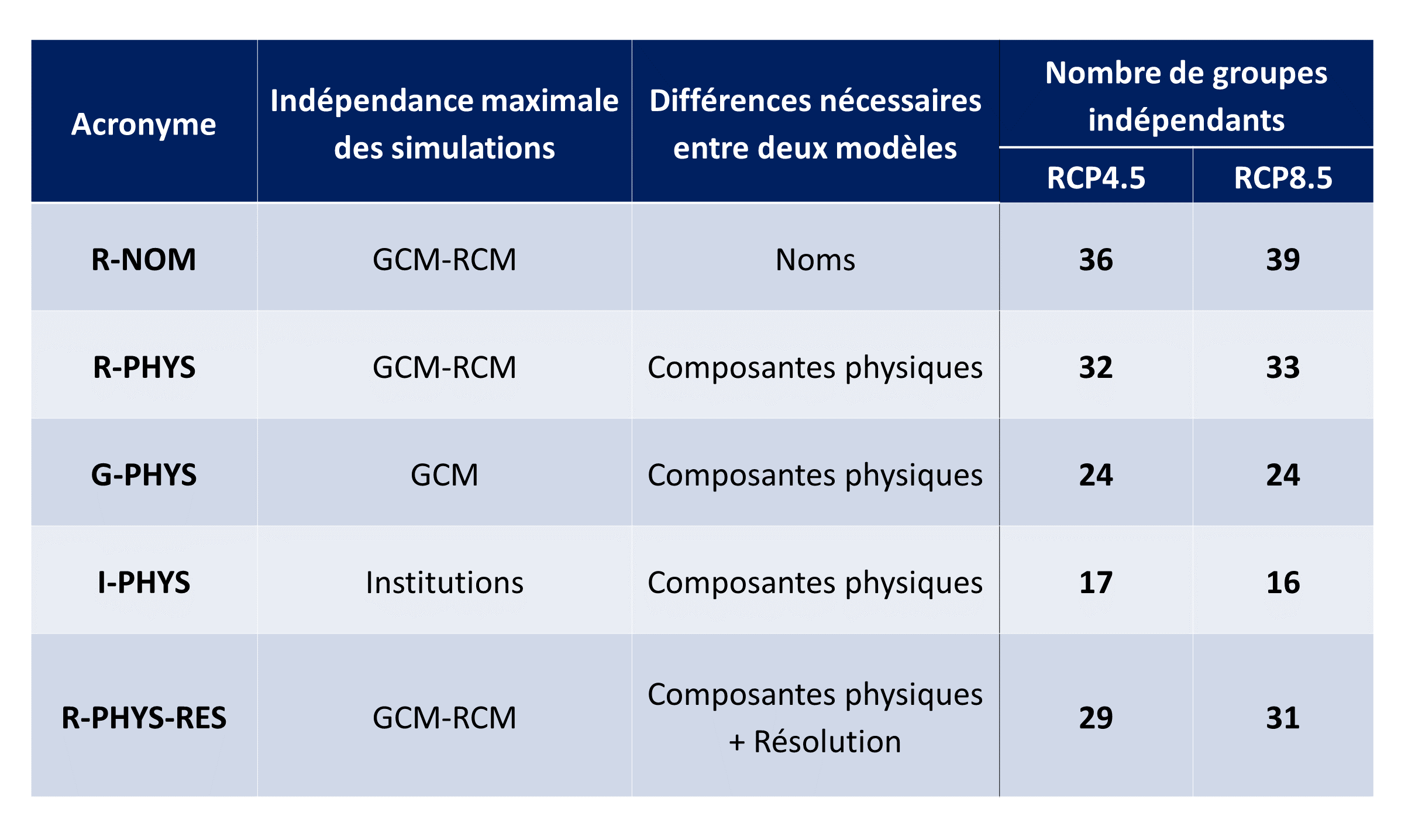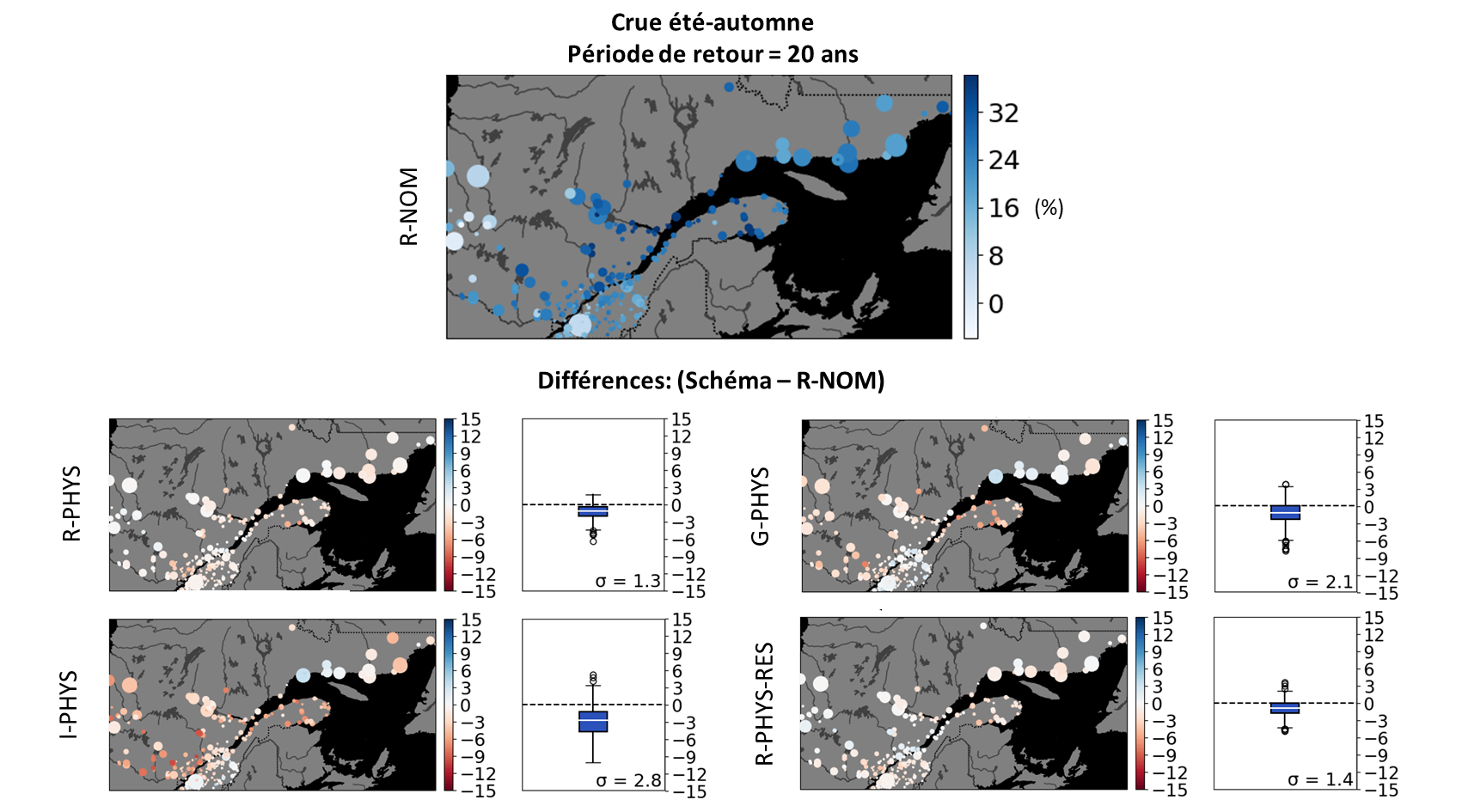Assessing the performance and uniqueness of hydrological simulations produced by a heterogeneous climate ensemble and recommending a weighting scheme for this ensemble to meet the needs of the INFO-Crue project
This project has advanced our understanding of how hydrological simulations in this type of ensemble must be combined to maximize the information contained in these projections.
Project details
Principal(s) investigator(s)


Context
To predict changing flood patterns in the context of climate change, the Direction principale des prévisions hydriques et de la cartographie (DPPHC) produced an ensemble of 1080 hydrological simulations covering the period from 1955 to 2100 for approximately 28,000 river sections in southern Quebec using the HYDROTEL model. These hydroloclimatic projections differ in their key data, which comes from a wide variety of climate models from the CMIP5, CORDEX and ClimEx ensembles, and in the parameters used in the hydrological model itself. An ensemble of this size is essential to properly assess the predicted changes in extreme flooding. However, as it is a highly heterogeneous ensemble, it cannot be analyzed without taking into account the performance and interdependence aspects of the climate data used and the results obtained. Thus, this research project explores alternatives to the “one model, one vote” methodology often used in response to these issues.
Objective(s)
-
Explore the different analysis frameworks for designing weighting schemes for the INFO-Crue hydroclimate simulation ensemble
-
Evaluate the performance and the level of duplication of the information contained in the hydroclimate simulation ensemble
-
Provide the DPPHC with a recommendation on the weighting to be applied to the hydroclimate scenarios
-
Explore the generation of future projections using degrees of warming rather than the classic time horizons approach
This project is part of the INFO-Crue initiative set up by the MELCCFP.
Methodology
-
Acquire hydrological indicators produced by the different versions of HYDROTEL for the 2022 Hydroclimatic Atlas of Southern Québec, as well as the equivalent indicators from the hydrological portrait
-
Assess the performance of the simulations for each river section and each hydrological indicator of interest
-
Create a genealogy of the climate models used in INFO-Crue
-
Quantify the independence and added value of these differences
-
Evaluate the added value of complex weighting schemes compared to the simpler alternatives frequently used in practice
-
Calculate certain hydrological indicators of interest for the horizons corresponding to the time when simulations reach +1.5, +2, +3 and +4°C compared with the industrial period
-
Compare projections using degrees of warming to conventional projections using time horizons
Results
An analysis framework was established to assess the performance of the hydroclimate simulations used for INFO-Crue for historical periods, as well as the level of independence of their climate change signal. The results are largely in agreement with the findings of several other studies. In fact, it remains difficult, if not impossible, to apply a single, universal “calibration.” In the specific case of INFO-Crue’s hydroclimate scenarios and the analyses carried out in this project, this means that for any section or indicator where certain conclusions can be drawn, there are other sections, indicators or time horizons where these conclusions do not hold true.
Thus, in terms of the performance of hydroclimatic simulations, it is difficult to paint a general portrait of the distribution of biases, because these vary widely depending on the hydrological indicator evaluated and the locations of the sections. An interesting conclusion is that the distribution of biases between the CMIP5, CORDEX, and ClimEx ensembles changes substantially depending on the HYDROTEL platform being evaluated. Even for the smallest watersheds or for indicators of extremes, regional models do not always differ from global models. Their performance seems to depend, among other things, on the parameters of the hydrological model.
The conclusions are of similar complexity when it comes to the level of independence of the simulations. For example, a principal component analysis showed that multi-member models such as ClimEx provide unique information and added value for extreme indicators such as the 100-year recurrence rate. However, this uniqueness rapidly decreases for less extreme indicators, for more distant time horizons and for the largest rivers.
For the purposes of INFO-Crue, whose aim is to support the mapping of flood zones across southern Quebec, it was therefore decided to:
-
Keep all the simulations, as it has been shown that none has poor performance for all indicators or river sections
-
Explore simpler weighting schemes that can be applied across the province uniformly
Consequently, several versions of the “one model, one vote” methodology were developed (Table 1) and compared in order to evaluate the sensitivity of the hydroclimatic projections to the weighting scheme. The analyses carried out as part of the project demonstrated that the results are robust regardless of the scheme used, especially because of the very high number of hydroclimate simulations.

Figure 1 illustrates the slight difference between the various schemes explored for summer-autumn floods with a 20-year recurrence. This suggests that the emphasis should not be on identifying a perfect universal scheme (this does not exist), but on better understanding the impact associated with this source of uncertainty by comparing or combining the results obtained using different hypotheses.

Figure 1: Magnitude (50th percentile) of changes expected for summer-autumn floods (Q1MAXEA) by 2071-2100 using a simple weighting scheme (R-NOM). The other panels illustrate the difference (absolute %) between the other schemes and R-NOM.
For all the indicators explored, even those associated with very rare extremes, the approach using degrees of warming provides a much clearer signal that is easy to describe and understand. For example, Figure 2 illustrates the models’ consensus on the direction of change for peak annual flood extent with a 100-year recurrence. Using the classic approach, it can be difficult to explain the changes in a simple way. Indeed, there is disagreement between the RCP4.5 and 8.5 scenarios.
Figure 2: Consensus among the models on the direction of expected changes for peak annual flooding extent (Q1MAXAN) using (top) the time horizon approach and (bottom) the degrees of warming approach.
Whether in the middle or at the end of the century, the RCP8.5 indicates a probable increase in flooding over a much larger area than the RCP4.5. As a result, the approach using degrees of warming is not only easier to describe, with the “blue” sections of Gaspésie in northern Quebec progressing from one figure to another, but it also makes it possible to explain the complexity of the time horizon approach. RCP8.5 is already warmer by 2041-2070 than RCP4.5 is at the end of the century, which explains the greater number of “blue” sections. This simplicity is explained, in particular, by the fact that this approach makes it possible to avoid certain sources of uncertainty, including uncertainty linked to greenhouse gas emission scenarios.
Benefits for adaptation
Retombées pour l'adaptation
The project advanced our understanding of how simulations should be combined in order to maximize the information contained in highly heterogeneous ensembles.
The recommendations provided to the DPPHC engineers helped produce the 2022 edition of the Hydroclimatic Atlas of Southern Québec.
Scientific publications
Funding

Other participants
-
Louis-Philippe Caron, Ouranos
-
Charles Malenfant, MELCCFP
-
Simon Lachance-Cloutier, MELCCFP
Related projects
703100